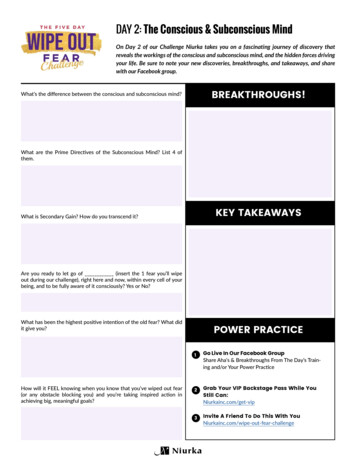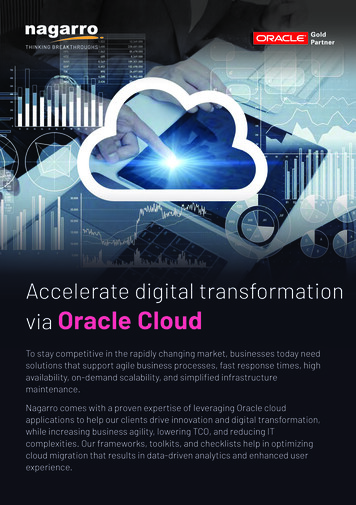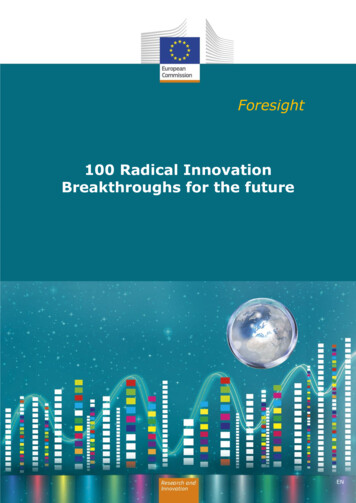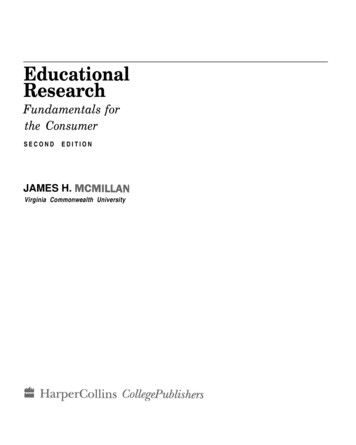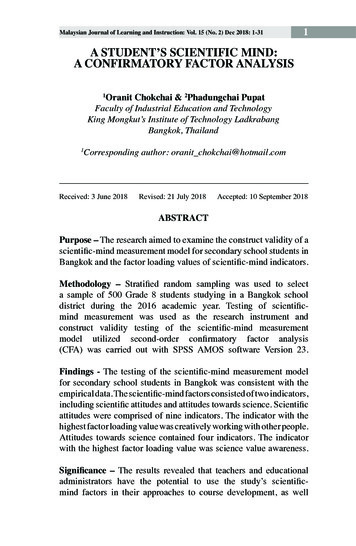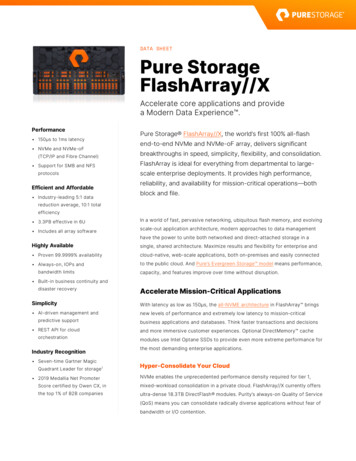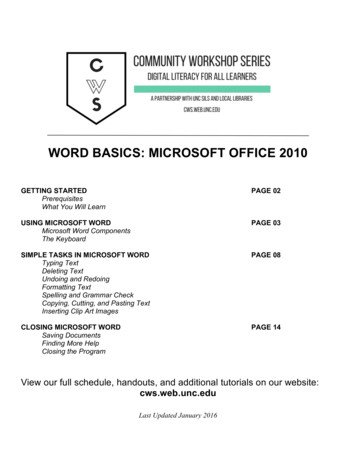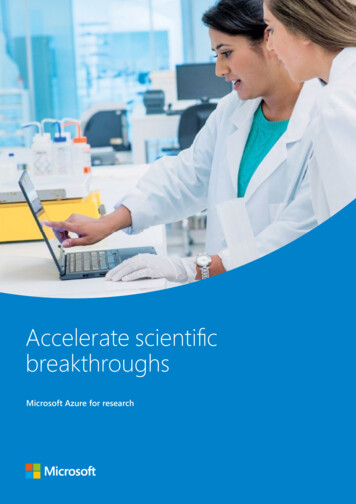
Transcription
Accelerate scientificbreakthroughsMicrosoft Azure for research
2 Accelerate scientific breakthroughs
Contents46810121414A science-led recoveryHelp your research team achieve more using the cloudSolve global problems at speedSharp minds need powerful technologyAdvanced scientific tools in easy reachUseful toolsNext stepsAccelerate scientific breakthroughs 3
A science-ledrecoveryAs the world recovers from the COVID-19 pandemic,economic disruption is colliding with problems likeclimate change. To map the way forward in a postcarbon future, we need smart minds working together –and time is of the essence.A new dawn for usWe have the expertiseHow science is done nowThe world is at a historic inflection point.By investing in a science-led economicrecovery, we can build a stronger andmore resilient future for all. With the rightstrategy to guide us, we can transitionfaster to a knowledge nation built on bigideas and innovative technologies—onethat’s ready to tackle problems like climatechange, food and energy security, globalcompetitiveness, our aging population,and disease.We have the research talent to spearhead ascience-led recovery. Universities across theworld are researching fields like chemistry,earth sciences, and engineering; andresearchers are pioneering everything fromsmart farms and agricultural robotics tosolutions for space junk.Sparking intense collaboration amongresearchers globally, the coronavirusoutbreak accelerated a new researchculture characterised by open datasets,rapid-fire exchange of knowledge onservers and an explosion in public papers.Scientists talk of an “extraordinary amount”of information.This strategy must focus on future-proofingour research capability to support excellentresearch at scale and must empower theentire innovation sector to work as one toconceive and commercialise the best ideas.Many of their discoveries can literally belife-changing. For instance, surgeons cannow see CT and MRI images in 3D duringsurgery. These crucial medical imagesexpand their reality, enabling them tooperate with greater precision. Or takea solar-based system that offers Kenyanfarmers personalised recommendationsand solutions through their mobilephones, to help them raise better qualityhighyield crops and make more money. Orconsider the impact of a new generationof solar panels that can efficiently producehydrogen gas out of thin air, of a novelprocess for cleaning up crude oil spills usingmagnets, or of a new vaccine that blocksthe chronic pain caused by osteoarthritis.It’s ideas like these that will ensure ourfuture. But to support their inception, weneed to equip our researchers for howscience is done now.4 Accelerate scientific breakthroughsTo contribute to the myriad incrementalincreases in knowledge that nourish thegreatest innovations, our researchers needto surface important findings, analysemassive datasets and share them so theycan reproduce each other’s experiments.To spearhead a science-led recovery, theyneed sustainable technology infrastructurethat supports open, collaborative science– plus the skills to use it to discover andcommercialise valuable ideas faster.
Extend your capabilities with oursMicrosoft Azure lets your research harness one of the world’s mostpowerful public clouds for research. Infinitely scalable compute resources based globally 99.95% monthly availability with 24/7/365 support Secure, on-demand access to vast storage and supercomputing resources No additional investment in capital assets or IT infrastructure, freeingresearch funding Sustainable zero emissions technologyDiving into dataThe public cloudMore and more, today’s academic research teams are using highperformance computing (HPC), artificial intelligence (AI), andmachine learning (ML) to delve into complex questions and powerscientific enquiry across huge datasets. Scaling from desktopsto supercomputers, they require large amounts of data storage,processing and analysis. Many are now using cloud computing tohelp meet these needs in a cost-effective way.The public cloud provides modern research infrastructure to extendyour own. Far more flexible than investing in your own technology,it allows researchers to dial up storage, compute when needed, anddial down when they’re done. With appropriate security to protectintellectual property (IP), academic research teams can shareimmense datasets with research partners and industry, acceleratinggame-changing discoveries.“Modern science is being called upon to solve globalchallenges at a rapidly increasing rate. The academic modelthat has driven research outputs in the past is strugglingto keep up with the pace of change and a new focus onconverting research into action The scientific communityneeds to embrace collaborative practises and harness thepower of globally connected IT infrastructure to makesolutions available when and where they are needed most.”Dr Justin Perry, Research Scientist and Project Leader, CSIROAccelerate scientific breakthroughs 5
Help your researchteam achieve moreusing the cloudResearchers around the world are using Microsoft Azureto accelerate their research. It provides an open, flexible,global platform that supports multiple programminglanguages, tools, and frameworks to enable faster results.Faster discoveriesWork easily with huge datasetsand use AI, HPC and Azurediscipline-specific tools toarrive at new insight faster.Virtual research teamsShare and manage code acrossresearch communities usingGitHub repositories. IntegrateIoT for remote sensing dataand enable hybrid working foryour team in a crisis.6 Accelerate scientific breakthroughs
Data managementand governanceMake research discoverable,apply data policy andprotect university IP with abest practice platform forautomating governance.Cost controlPay for computing resourcesonly when needed, plus useAzure tools to optimise cloudworkload costs, reducing totalcost of ownership.Quality controlStudents can view project data,upload results, and run analyticsworkloads with role-based accessprotecting data integrity.Best practice codeSoftware engineers andresearchers can use Azure’sbestpractice coding toolsetsto create custom researchsoftware to solve new scientificchallenges.Accelerate scientific breakthroughs 7
Solve globalproblems at speedTo find answers to big challenges like climate changeand pandemics, scientists in data-intensive fields likeclimatology and epidemiology are interrogating immensedatasets to reveal the complex interplay of factors drivingnatural phenomena and disease. The Azure platform helpsthem turn evidence to conclusions more quickly.Faster discoveriesSolve complex problemswith big dataMake headway in data-intensive fields likeastrophysics, geophysics, and genomics.In minutes, researchers can set up costeffective Azure infrastructure to ingest,store, and share their biggest datasets.It’s easy to add computing power tofurther investigate data using modelling,simulations, and analysis. Or to importAzure Open Datasets to train ML modelsusing public data on weather, city safety,and more.Build on what came beforeSee things differentlyWith thousands of new findings comingout of the worldwide scientific communitydaily, Azure AI can help researchersdigest the “extraordinary amount” ofinformation and stay on top of their fieldsby surfacing relevant finds and data inscientific literature. And to help researchersreproduce findings and take the nextstep, Azure makes information morediscoverable with best-practice governanceand collaboration.Arrive at new insight with big data toolsbuilt for the Azure platform and availableon demand, including HPC, AI, ML, anddata analytics. Azure helps your team adaptcode to the world of big data and thecloud, plus you can use our intelligent toolsto reveal new patterns, relationships andtrends in research data. There’s no need forcapital outlay—simply switch the tools youneed on or off to suit research timelines.CASE STUDYIoT helps preserve ancient Roman ruinsA team of engineers at the Politecnico di Milano provided archeologistssurveying a restricted underground site in Rome with the smart-sensortechnology they needed to determine the impact of environmental factorson the sculptures and frescoes. The team used Azure to create a simplifiedIoT-based system that could deliver the collected data in customisable,easy-to-use graphs, with different tabs for different sensors and filters.“ When the archeologists were shown they could simply selectthe metric and a time window to see the data readings, it wasfantastic for them. The Azure solution provided the data theyneeded in a way that made it valuable.”Luca Mottola: Associate Professor, Politecnico di Milano, Italy Massey8 Accelerate scientific breakthroughs
Virtual research teamsCollaborationAzure lets everyone working on a researchchallenge access the latest data so youcan collaborate across entire disciplinesand industries. Data integrity is protectedby access controls with multiple layers ofsecurity and governance, so you can cocreate knowledge with global experts andcitizen scientists alike. On BRUVnet, they’repopulating the world’s largest trainingdataset of fish species this way. With Trove,you can pay people for the photos youneed to train ML models.Easily share ideas, methodologyand researchStartling innovations can result whenresearchers connect data points andinsights across existing knowledge andscrutinise and reproduce each other’s work.Azure enables this with an open, flexible,fast, efficient infrastructure for sharing largedatasets and findings. With research data attheir fingertips, researchers can collaborateeasily, plus replicate experiment results onother researchers’ datasets to strengthenthe foundation for future enquiry.Resilient in a crisisThe COVID-19 pandemic has underscoredthe importance of resilient researchinfrastructure that supports flexible workstyles, including remote working andhybrid working. With Azure, you can keepresearchers connected and productivewherever they are. You can easily integrateTeams, SharePoint, and OneDrive sothey can disseminate their results andcommunicate more effectively. Power BIhelps them manage shifting priorities withup-to-the-minute reporting tools.CASE STUDYUsing Azure to accelerate research atprominent Pakistani research centerResearchers at the International Center for Chemical and Biological Sciences inPakistan were having trouble computing, storing, and managing the data fromtheir DNA sequences. Azure created the perfect environment for acceleratedresearch by providing scalable storage capacity and effective computing power,which users could access simultaneously. The platform was also used to create aninterface for their learning website and store thousands of video-lectures.“Azure has helped through massively scalable storage. Theinfrastructure on Azure streamlined our platform to matchour needs, providing us with a single platform to monitor andanalyse our data requirements and scale accordingly.”Dr. Ishtiaq Ahmad Khan, Assistant Professor, Jamil ur Rehman Center for Genome ResearchAccelerate scientific breakthroughs 9
Sharp minds needpowerful technologyNow even the smallest research teams have the computingfirepower to investigate science’s biggest questions. On Azure,there’s no capital outlay, no on-premise hardware to maintain,and data controls and governance are built in. Simply pay forwhat you use—and scale up and down as needed. Plus, spark newways of seeing data with HPC, ML and other tools on demand.Data management and governanceManage rapid data growth easilyScale your Azure research infrastructureeasily to keep pace with scientificbreakthroughs and collaborationopportunities. You can add on-demandstorage and backup to suit any researchrequirement—all with best-practice securityand governance. Data tags enable finegrained life cycle management, curtailingdata and budget bloat.Make research findingsdiscoverableData saved on hard drives and thumbdrives doesn’t fuel the future ofcollaborative science—and it’s vulnerableto loss, theft, and corruption. Azureprovides a universal platform to ingest andshare every researcher’s data. Policy-basedtags impose a common logic, helping tosurface data to the right scientific andindustry collaborators.CASE STUDYA massive high-performance computingexperiment enabled by AzureThe University of New South Wales (UNSW) can respond faster to challengeslike the COVID-19 pandemic with Azure providing a single source of truth forreporting. UNSW used Azure Databricks to create a second Azure data laketo store curated data. Workers can create their own reports from this data inrecord time using Power BI. UNSW is now exploring using AI and ML to analysethe data to identify contract cheating and more.“Microsoft support was outstanding. Access to theirsoftware architects, specialising in open source, help indesigning the experiment and providing 24/7 support.”Assi Barak, Software Group Manager, Bar-Ilan University, Center for Research inApplied Cryptography and Cyber Security10 Accelerate scientific breakthroughsProtect your IPThere’s a misconception that the cloudisn’t for sensitive data. In fact, it can helpprevent catastrophic loss and data leaksresulting from compromised universityservers. Security and sound governance arebuilt into Azure and constantly updated.Fine-grained access controls protect datasafety, integrity, and reproducibility—andyour IP.
Cost controlScale out to a supercomputerReduce technical overheadSimplify your ITEmpower researchers to take control oftheir technology budgets and eliminatewaits for computing resources. Azureoffers a cost-effective resource modelwith no capital outlay. You can start withwhat you need today and scale out to asupercomputer tomorrow. Switch on HPC,analytics, AI, and ML instantly, plus accessdiscipline-specific tools like Cromwell orFarmBeats on demand to accelerate insight.It makes no sense to duplicate or underutilise expensive equipment. Why not payonly for the time you need? With Azure,you can make the most of scarce fundingby reducing on-premise hardware and,with it, total cost of ownership. You can alsomaximise the value of your infrastructureinvestment by storing operational,compliance, production, and research dataon the same Azure system.Boost productivity with a cloud solutionthat’s built to integrate with you. Azureautomation makes it easy to ingest,manage, and analyse data, saving time.Alerts help control cloud workload costsso researchers stay on budget. And byoutsourcing technology maintenance,upgrades, and IT resources, your IT teamcan deliver more value by working on yourinstitution’s strategic priorities instead.CASE STUDYAzure, asteroids and AIJohn Hefele used Azure Batch to spin up 200 virtual machines in about15 minutes. He ultimately scaled to 500 VMs. He was able to generate amillion asteroid trajectories in just nine hours—a task requiring at leastthree weeks on the university’s supercomputer, a shared resource that’shard to access. He used the data to train a neural network that identified11 asteroids that could impact Earth and weren’t yet flagged as a threat.“[People] assume that cloud computing is going tobe really expensive, but I was able to generate amillion simulations using Azure Batch for just 150.”John Hefele, PhD candidate, Leiden UniversityAccelerate scientific breakthroughs 11
Advanced scientifictools in easy reachNow even the smallest research teams can use AI, HPC anddiscipline-specific tools created for the Azure platform.No huge overheads – simply pay for what you use.Perform large-scaleparallel and HPCbatch jobs efficientlyBuild, train, and deployAI models collaborativelyat scaleIntegrate data from fielddevices or leverage AI insmart farmingAzure Batch and Batch ShipyardAzure DatabricksRun large-scale applicationsefficiently in the cloud with cloudscale job scheduling and computemanagement. Docker and Singularitycontainerised workflows don’trequire infrastructure setup. AddAzure Kubernetes Service (AKS)to help deploy and managecontainerised applications.Work at scale with AI modelsusing GPU-enabled clusters withthis Apache Spark-based analyticsservice. Databricks Runtime comespreinstalled and preconfiguredwith deep learning frameworksand libraries e.g. TensorFlow,Keras, and XGBoost.Azure IoT,including FarmBeatsBuild, train, and deployML algorithms and enablereproducible ML researchAccess the latest researchAzure Machine LearningSynchronise MAG to your AzureStorage accounts and see yoursearches in a heterogeneousknowledge graph—find scientificpublication records and seecitation relationships, authors,institutions, journals, conferences,and fields of study.Whatever your level of AI expertise,get up and running quickly witheverything from automated machinelearning (AutoML) to low-code dragand-drop tools (Azure ML designer),to full code with Jupyter Notebooks.Azure ML automates deploymentand downscale of compute clusters.12 Accelerate scientific breakthroughsMicrosoft AcademicGraph (MAG)Securely connect, monitor, andmanage billions of devices todevelop Internet of Things (IoT)applications. Easily integratemeteorological, satellite, and sensordata plus other IoT feeds.Manage expandingdata efficiently witha scalable systemAzure Storage (Blob,Disks, Data Lake)Azure Blob storage providesmassively scalable, secure storagefor your unstructured data. Forcritical workloads, disk storage isdynamically scalable. Extend yourcurrent storage systems easily byintegrating an Azure Data Lake.
Analyse largegenomic datasetsCromwell on AzureOrchestrate thecomputing tasks neededfor genomic analysis withan open source scientificworkflow managementsystem that lets you runscripts on local machinesor computing clusters,plus the cloud.Share largedatasets withresearch partnersAzure Data Share,Azure IndustryCollaborative ServiceShare researchdatasets with multiplecollaborators withfine-grained controls.Enhance insights byeasily combining datafrom third parties toenrich analytics andAI scenarios.Manage HPCclusters onthe cloud costeffectivelySimplify datasciencein the cloudCycleCloudData Science VirtualMachinesDynamically provisionHPC Azure clustersand orchestrate dataand jobs for hybridand cloud workflows.Compatible with Slum,Kafka, Zookeeper, PBS,Anaconda, and more.Get started quicklywith Azure VirtualMachine images (Linux/Windows), pre-installed,configured, and testedwith tools widely used indata analytics, machinelearning, and AI training.Manage lowlatency for realtimeinference or modelscoring requestsUse off-the-shelfcapabilities to trainML algorithms andkeep AI costs downField ProgrammableGate Arrays (FPGAs)Azure CognitiveServicesAzure FPGAs enableultra-low latencyinferencing, even with asingle batch size, usingResNet 50, ResNet 152,DenseNet-121, VGG-16.Tailor your AI capabilitiesto your specific needsusing custom-developedmodels based onour broad range ofAI services.Achieve real highperformancecomputing (HPC)on a public cloudInfiniBandenabled HPCEnable MPI and RDMAworkloads to run rapidlyat scale with computeand GPU resourcesconnected over a lowlatency, highthroughput network.Make researchreproducibleAzure Open DatasetsImprove the accuracy ofyour ML models and savetime on data discoveryand preparation byintegrating ready-to-usepublic datasets straightfrom Azure services intoyour own ML workflows.Accelerate scientific breakthroughs 13
Useful toolsResearchers around the world are using Microsoft Azure to accelerate theirresearch. It provides an open, flexible, global platform that supports multipleprogramming languages, tools, and frameworks to enable faster results.Azure pricingAzure calculatorAzure Cost ManagementOCRE customers can find the currentAzure public pricing by product/serviceat -pricingCustomers wishing to confirm costs ofdeploying services to Azure can leveragethe Azure pricing calculator to enter thetype, quantity, and preferred purchaseoption i.e. PAYG or Azure Reservationsby using the Azure Calculator at or/All OCRE members purchasing Azureunder Volume Licensing will be entitled touse the Azure Cost Management solutionfree of charge. Azure Cost Managementhelps organisations visualise, manage, andoptimise costs across Azure.Next stepsMaking Azure adoption easierThe OCRE framework, available to GÉANT members, enables over 10,000universities and research institutions, served by 40 National Research andEducation Network (NREN) organisations across Europe, to benefit from: Significant discounts across Microsoft Azure services Ready to use contracts designed to satisfy national and European public sectorprocurement regulations and GDPR requirementsContact your Microsoft OCRE Partner who will work with you and support yourAzure journey. Microsoft Azure – Learn more The Open Clouds for Research Environment (OCRE) Framework – Learn more GÉANT – Learn more14 Accelerate scientific breakthroughs
Accelerate scientific breakthroughs 15
commercialise valuable ideas faster. A science-led recovery As the world recovers from the COVID-19 pandemic, economic disruption is colliding with problems like climate change. To map the way forward in a post-carbon future, we need smart minds working together - and time is of the essence. 4 Accelerate scientific breakthroughs
